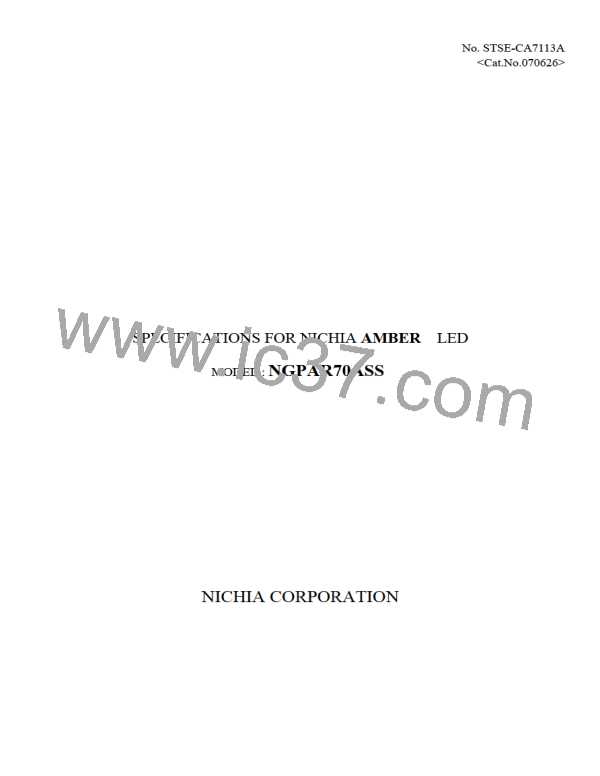Nichia STSE-CA7113A
<Cat.No.070626>
(3) Soldering Conditions
· Nichia LEDs uses a copper alloy lead frame which provides a high thermal conductivity.
stress such as soldering heat may reduce the reliability of the product; particular caution should be
Thermal
used to avoid damage prior to and during soldering.
listed in the following table.
The recommended soldering conditions are
· Solder the LED no closer than 1.6mm from the base of the stopper.
· The mechanical stress by clinching will cause degradation of the reliability on the LEDs. It is
important to minimize the mechanical stress on the LEDs.
that it will not cause any problem when using it.
· Recommended soldering conditions
Dip Soldering
It should be confirmed beforehand
Hand Soldering
Pre-Heat
120°C Max.
Temperature
350°C Max.
Pre-Heat Time
Solder Bath
Temperature
Dipping Time
60 seconds Max.
260°C Max.
Soldering Time
Position
3 seconds Max.
No closer than 1.6 mm from the
base of the stopper.
5 seconds Max.
Dipping Position No lower than 1.6 mm from the
base of the stopper.
· Although the recommended soldering conditions are specified in the above table, dip or hand
soldering at the lowest possible temperature is desirable for the LEDs.
· A rapid-rate process is not recommended for cooling the LEDs down from the peak temperature.
· Dip soldering should not be done more than one time.
· Hand soldering should not be done more than one time.
· Do not apply any stress to the lead particularly when heated.
· The LEDs must not be repositioned after soldering.
· After soldering the LEDs, the epoxy bulb should be protected from mechanical shock or vibration until
the LEDs return to room temperature.
· Direct soldering onto a PC board should be avoided.
from warping of the PC board or from the clinching and cutting of the leadframes.
absolutely necessary, the LEDs may be mounted in this fashion but the User will assume responsibility
for any problems. Direct soldering should only be done after testing has confirmed that no damage,
such as wire bond failure or resin deterioration, will occur. Nichia’s LEDs should not be soldered
Mechanical stress to the resin may be caused
When it is
directly to double sided PC boards because the heat will deteriorate the epoxy resin.
· When it is necessary to clamp the LEDs to prevent soldering failure, it is important to minimize
the mechanical stress on the LEDs.
· Cut the LED leadframes at room temperature.
cause failure of the LEDs.
Cutting the leadframes at high temperatures may
(4) Cleaning
· It is recommended that isopropyl alcohol be used as a solvent for cleaning the LEDs. When using
other solvents, it should be confirmed beforehand whether the solvents will dissolve the resin or not.
Freon solvents should not be used to clean the LEDs because of worldwide regulations.
· Do not clean the LEDs by the ultrasonic. When it is absolutely necessary, the influence of ultrasonic
cleaning on the LEDs depends on factors such as ultrasonic power and the assembled condition.
Before cleaning, a pre-test should be done to confirm whether any damage to the LEDs will occur.
-5-

 NICHIA [ NICHIA CORPORATION ]
NICHIA [ NICHIA CORPORATION ]